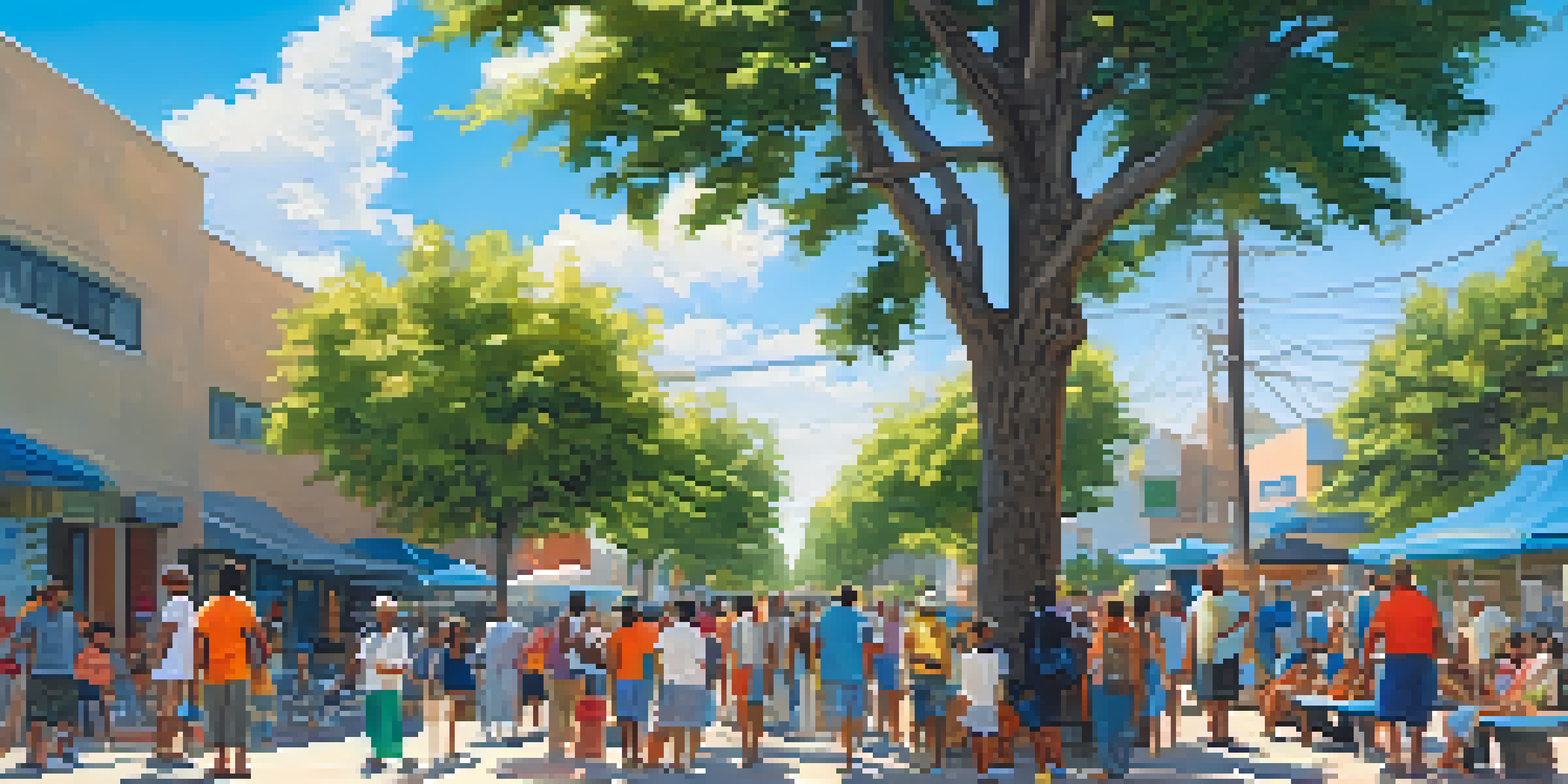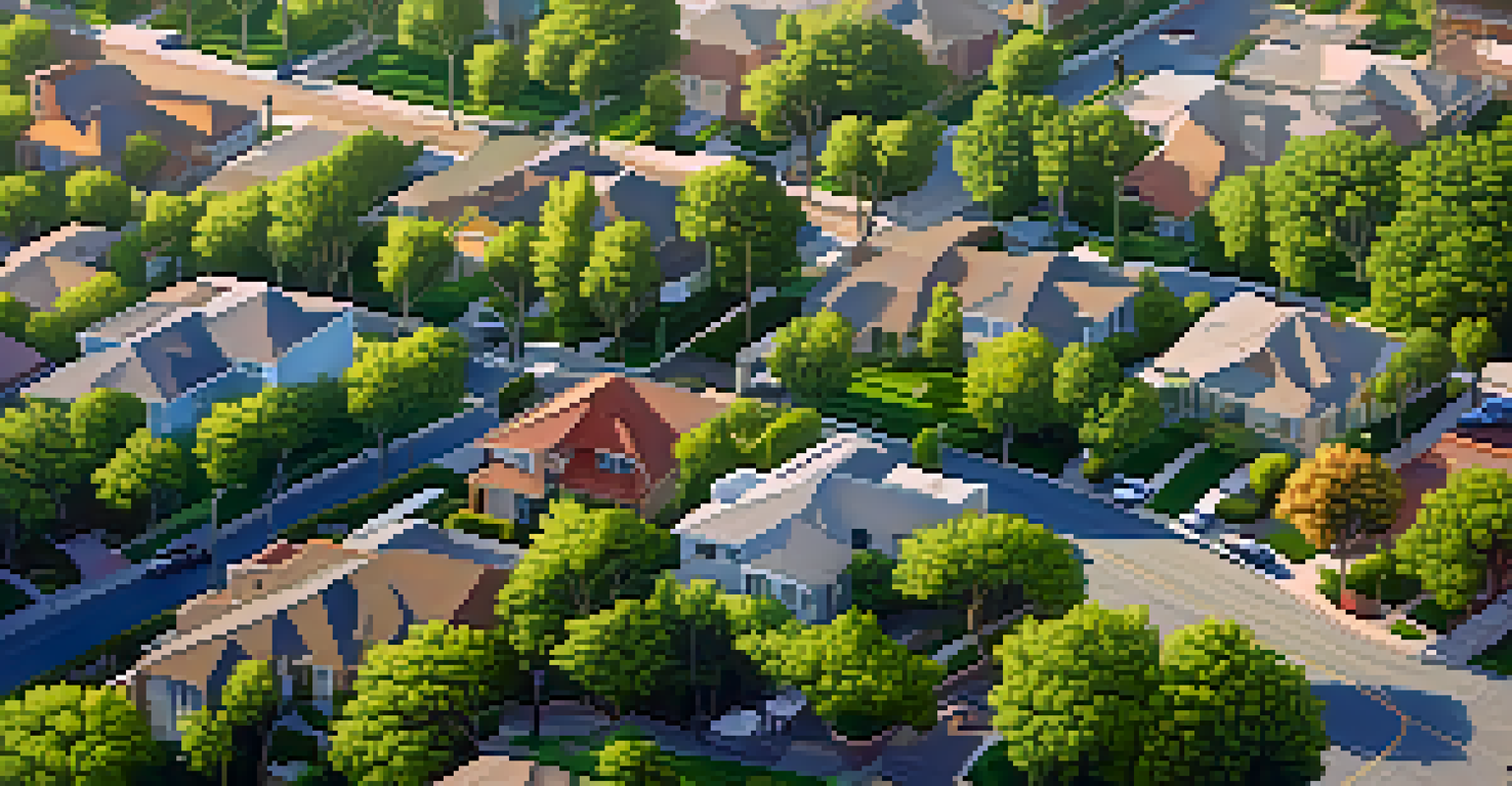Heat Waves in Los Angeles: Public Health and Safety Measures

Understanding Heat Waves and Their Impact on LA Residents
Heat waves are prolonged periods of excessively high temperatures, often combined with high humidity. In Los Angeles, these extreme weather events can pose serious health risks, particularly for vulnerable populations like the elderly and those with pre-existing conditions. With the city’s unique geographical features, such as urban heat islands, temperatures can soar much higher than surrounding areas.
In the midst of every crisis, lies great opportunity.
As the climate continues to change, the frequency and intensity of heat waves are expected to rise. This not only affects daily life but also increases the potential for heat-related illnesses, such as heat exhaustion and heat stroke. Understanding the signs and symptoms of these conditions is crucial for keeping oneself and others safe during these sweltering days.
Moreover, the impact of heat waves extends beyond individual health. They can strain public health systems, disrupt daily activities, and lead to higher energy consumption as residents crank up their air conditioning. It's essential for Los Angeles residents to stay informed and prepared for these scorching challenges.
Identifying Vulnerable Populations in Heat Waves
Certain groups are more susceptible to the adverse effects of heat waves. Elderly individuals, children, and those with chronic illnesses may struggle to regulate their body temperatures effectively. Additionally, people living in low-income neighborhoods often lack access to air conditioning or safe, cool spaces, making them particularly at risk during extreme heat events.

Those who work outdoors, such as construction workers and agricultural laborers, also face heightened risks during heat waves. Prolonged exposure to high temperatures without proper hydration and rest can lead to serious health complications. Recognizing these vulnerable groups helps in tailoring public health responses and safety measures.
Heat Waves Threaten Vulnerable Groups
Elderly individuals, children, and those with chronic illnesses are particularly at risk during heat waves due to their inability to regulate body temperature effectively.
Community awareness and support systems are vital during these times. Encouraging neighbors to check on each other, especially the elderly or disabled, can make a significant difference in preventing heat-related illnesses. Building these social networks can help ensure that everyone has the resources and support they need to stay safe.
Heat-Related Illnesses: Prevention and Symptoms
Heat-related illnesses can range from mild conditions, like heat cramps, to severe issues such as heat stroke, which can be life-threatening. Symptoms of heat exhaustion include heavy sweating, weakness, and dizziness, while heat stroke may manifest as a high body temperature, confusion, and loss of consciousness. Knowing these symptoms can help individuals recognize when to seek medical attention.
The greatest threat to our planet is the belief that someone else will save it.
To prevent these illnesses, it’s essential to stay hydrated and avoid strenuous activities during peak heat hours. Drinking water regularly, even if you don’t feel thirsty, is crucial. Wearing lightweight, loose-fitting clothing can also help your body cool down more effectively.
Additionally, seeking shade or air-conditioned environments can significantly reduce the risk of heat-related illnesses. If you or someone you know is showing symptoms, it’s important to act quickly by moving them to a cooler place and providing water. Early intervention can save lives during extreme heat conditions.
Public Health Campaigns to Raise Awareness
Public health campaigns play a vital role in educating Los Angeles residents about the risks of heat waves and how to stay safe. These initiatives often include distributing flyers, hosting community workshops, and utilizing social media to spread awareness. By informing the public about the dangers of heat and the importance of hydration, these campaigns can help mitigate health risks during heat waves.
Local health departments frequently collaborate with community organizations to reach vulnerable populations. This collective effort ensures that information about heat safety is accessible to everyone, particularly those who may not have reliable access to digital resources. Multilingual resources can also be critical in diverse communities to ensure that language barriers do not hinder understanding.
Public Health Campaigns Raise Awareness
Local health departments and community organizations collaborate on campaigns to educate residents about heat safety, emphasizing hydration and recognizing heat-related illnesses.
The effectiveness of these campaigns is often measured through community outreach and feedback. Engaging residents in discussions about their experiences and challenges during heat waves can provide valuable insights for future initiatives. By fostering a culture of awareness and preparedness, Los Angeles can better protect its residents from the impacts of extreme heat.
City Resources for Staying Safe During Heat Waves
Los Angeles offers several resources to help residents stay safe during heat waves. The city operates cooling centers, which are air-conditioned public spaces where individuals can seek refuge from the heat. These centers are often located in libraries, community centers, and other public buildings, providing a safe haven for those without access to air conditioning at home.
The city also provides information on how to recognize signs of heat stress, as well as guidelines for staying hydrated and cool. Local officials often issue heat advisories to alert residents when temperatures are expected to rise significantly, prompting everyone to take necessary precautions. Staying informed through these advisories can make a huge difference in personal safety.
In addition to cooling centers, the city encourages residents to utilize public transportation during extreme heat days. Buses and trains provide air-conditioned environments, allowing individuals to travel safely without exposing themselves to the heat. Taking advantage of these resources can help ensure that everyone in Los Angeles can stay safe and cool.
Community Initiatives: Building Resilience Against Heat
Community initiatives are essential in building resilience against the effects of heat waves in Los Angeles. Neighborhood groups often come together to develop programs that focus on heat preparedness, such as organizing cooling stations or distributing fans to those in need. These grassroots efforts can create a safety net for vulnerable residents who may not have access to essential resources.
Moreover, local schools and organizations often collaborate to educate children and families about heat safety. By instilling knowledge at a young age, communities can raise awareness and promote safe practices that last a lifetime. Engaging youth in these initiatives not only empowers them but also fosters a sense of community responsibility.
City Resources Aid Heat Wave Safety
Los Angeles provides cooling centers and heat advisories to help residents stay safe during extreme heat, alongside promoting the use of air-conditioned public transportation.
Creating a culture of preparedness and support can have lasting benefits, not just during heat waves but throughout the year. By fostering connections and encouraging proactive measures, communities can enhance their overall resilience, ensuring that every resident feels safe and supported when temperatures rise.
Long-Term Strategies for Mitigating Heat Effects
While immediate measures are crucial for protecting health during heat waves, long-term strategies are equally important. Urban planning plays a significant role in mitigating heat effects; incorporating more green spaces, trees, and reflective materials in city infrastructure can help lower overall temperatures. These changes not only enhance aesthetics but also create cooler environments for residents to enjoy.
Additionally, promoting energy-efficient buildings and sustainable practices can reduce the urban heat island effect. As cities expand, it’s vital to prioritize eco-friendly designs that incorporate natural cooling methods. This approach not only benefits the environment but also contributes to a healthier urban atmosphere.

Finally, engaging with climate scientists and public health experts can help shape policies that address the root causes of rising temperatures. By investing in research and community education, Los Angeles can create a more sustainable and resilient future, ensuring that residents can thrive even as the climate changes.